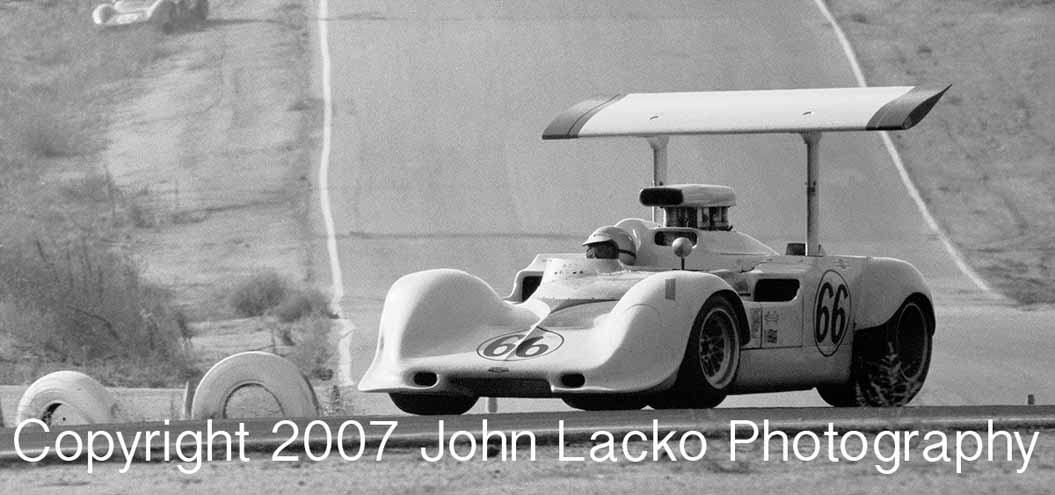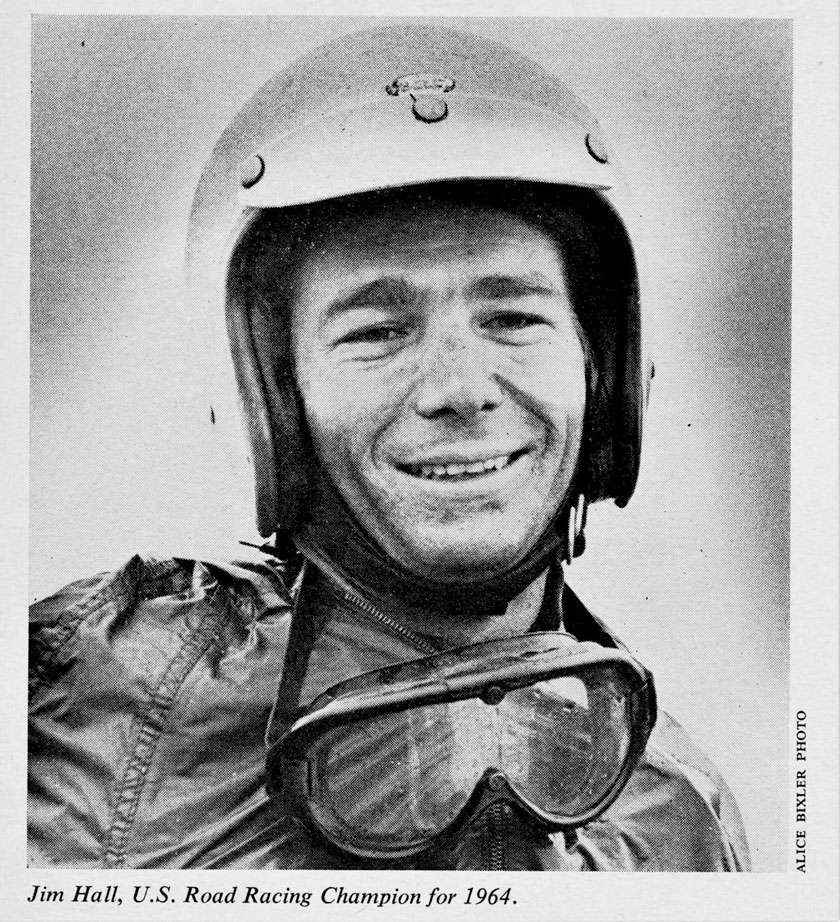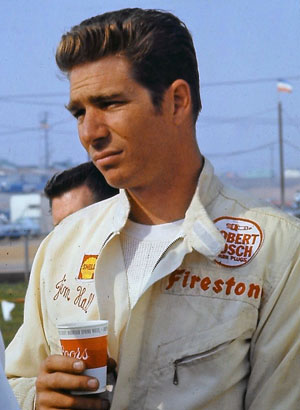Jim Hall (born 23 July 1935 in Abilene, Texas) is a retired American racing driver, race car constructor, and team owner.
While he is best known as a car constructor, he was one of the greatest American racing drivers of his generation, capturing consecutive United States Road Racing Championships (1964, 1965), two Road America 500s (1962, 1964), two Watkins Glen Grands Prix for sports cars (1964, 1965), the 1965 Canadian Grand Prix for sports cars, the 1965 Pacific Northwest Grand Prix, and scoring a massive upset at the 1965 12 Hours of Sebring over a contingent of factory-backed Ford GTs, Shelby Daytona Coupes and Ferrari entries.
If anything Hall’s accomplishments behind the wheel have been overshadowed by his pivotal contributions to race car design through his series of Chaparral sports racing and Indy cars. Hall’s cars won in every series in which they competed: USRRC, Can-Am, Trans-Am, Formula 5000, World Sportscar Championship, Autoweek Championship, Canadian Sports Car Championship, and the Indianapolis 500. Info from Wiki
Bio by Stephen Latham
Jim Hall competed in World Championship Grands Prix and numerous non-Championship races but he had a big impact in motorsport due to his Chaparral Cars. During the 1960s, in the USRRC and later in Can-Am, the cars were the most innovative in racing. He applied the use of aerodynamics to his race cars very early on and was the first to use aic transmissions in the cars, which allowed the drivers a free foot to operate moveable spoilers for aerodynamics.
Born in Abilene, Texas, he spent his early years growing up in New Mexico but unfortunately his father, a Texas oilman, along with his wife and daughter were killed in an plane crash and Jim continued his schooling while his brothers would run the business.
While only fourteen he acquired a 1929 Model A Ford which he modified and rebuilt into a hot rod, then had an Allard, followed by his brother’s Austin Healey. In 1954 he and his brother went to a race in New Mexico, and for fun entered his brother’s car in a novice race but though he dropped out they weren’t deterred and determined to buy a proper racing car. When they eventually got the car, although intent on buying a Porsche 550, they came away with a 3-litre Ferrari Monza 750S.
In 1960 with an F2 Lotus 18 , he made an impressive GP debut at Riverside and was running fifth until retiring on the last lap.
In the following year he won at Palm Springs in a Cooper Monaco and at Las Vegas in a Birdcage Maserati then commissioned Scarab specialists, Dick Troutman and Tom Barnes, to build a front-engined aluminum-bodied car for him. This would be the first Chaparral and in its debut race at Laguna Seca he finished second. He would go on to win the June Sprints and the Road America 500 at Elkhart Lake (co-driving with Hap Sharp) plus raced a Lotus 21 Climax to victory in the Hoosier GP at Indianapolis, beating Hap Sharp, Dan Gurney and Roger Penske. There was also a fourth place in the non-championship Mexican GP and in the Los Angeles Times GP at Riverside he finished second in the Chaparral 1 behind Roger Penske, though ahead of Masten Gregory, Bruce McLaren and Innes Ireland.
For 1963 he joined the BRP team in F1 and twice finished in the points (fifth in Britain and fourth in Germany), took a fourth place in the Glover Trophy and there were sixth place finishes in the Lombank Trophy and at the Solitude GP. During this time he built the first Chaparral 2 and they won at Laguna Seca, Watkins Glen, Road America and at a 200 mile Daytona race.
After this he returned to sports cars, winning the USRRC for Chaparral, and in the following year the mark 2 Chaparral won a wet Sebring 12 Hours (with Hap Sharp) and took a further six victories in the series. From this Jim concentrated on Can-Am and his cars won World Sportscar Championship races at the Nürburgring in 1966 and Brands Hatch in 1967.
Unfortunately, in the Stardust Can-Am GP in Las Vegas in 1968 he rolled his Chaparral 2G, destroying the car and spent nine weeks in hospital recovering from broken legs and jaw. He eventually returned but was severely scalded when he crashed while testing at Rattlesnake Raceway (his own two-mile road course outside their base in Midland, which was used for testing plus local club racing).
Jim’s racing would eventually wind down and after racing a Camaro in the 1970 Trans-Am Championship, he retired from racing.
He was inducted into the International Motorsports Hall of Fame in 1997, the Motorsports Hall of Fame of America in 1994 and received the Caltech Distinguished Alumni Award in 2001 while the Permian Basin Petroleum Museum in Midland has a section devoted to Jim Hall and Chaparral Cars.
The photos are mostly ones I bought at autojumbles while one or two didn’t have information to credit the photographer.
Although he raced himself, I felt Jim Hall’s work involving his amazing Chaparral Cars needed to be posted.
Apologies if any of these details, and car histories, are out of sequence as there was a lot of development over the years involving the Chaparrals!
Founder and charter member of the West Texas Region of the SCCA, Jim Hall’s drives included an F2 Lotus 18, a Cooper Monaco, a Birdcage Maserati, a Lotus 21 Climax and a Lotus 24, but he has a special place in motorsports history due to his revolutionary Chaparral Cars. He applied aerodynamics very early on and was the first to use aic transmissions in them (which allowed the drivers to use a foot to operate moveable spoilers for aerodynamics)
Born in Abilene, Texas, he spent his early years growing up in New Mexico and while only fourteen he modified and rebuilt a 1929 Model A Ford into a hot rod. Sadly, his father was killed in aeroplane crash, along with his mother and sister, and while he continued his studies his brothers ran the family business.
In 1957 Jim, and brother Dick, joined Carroll Shelby in running his Dallas sports car dealership and then at a local race in 1958 he met John ‘Hap’ Sharp who would go on to be his partner at Chaparral Cars. Their business was based in Midland, Texas, and also had its own two-mile road course (Rattlesnake Raceway) for testing and they allowed it to be used for club races.
They commissioned Scarab specialists Dick Troutman and Tom Barnes to build their first Chaparral, a front engined car with a tube frame, four wheel disc brakes, independent suspension and powered by a Chevrolet engine. The car was small and light and when he tested the prototype at Riverside in 1961 he came within three seconds of defeating Dan Gurney’s lap record and at his first race, at Laguna Seca, he finished second.
1962 saw victories in the June Sprints and the Road America 500 at Elkhart Lake (co-driving with Hap Sharp) and work also began on Chaparral 2, a mid-engined, fibreglass-bodied monocoque chassis.The Chaparral 2 first raced in 1963 and developed into a highly competitive car, taking victories at Laguna Seca, Watkins Glen, Road America and at the Daytona 200 mile race.
The following year saw them dominate the 1964 USRRC, taking victory after victory, and while he recovered from a broken arm, Roger Penske took wins at Laguna Seca and in the Nassau Speed Week.
In 1965, Jim and Hap took a stunning win in the Sebring 12 Hours, taking pole position, fastest lap and victory and it was another highly successful season in USRRC and FIA races. Later in the year,the Chaparral 2C was produced, which had a conventional aluminium chassis and a semi-aic transmission, with the clutch replaced by a three-stage torque converter. Its innovative adjustable rear wing was designed to lie flat for low drag on the straights and tip up under braking through the corners and the semi-aic transmission allowed the driver’s foot to operate the wing mechanism. Jim nicknamed it the EBJ (the ‘eye ball jiggler’) and the aluminium 2C chassis would later be used as a basis for an open 2E Can-Am racer.
In 1966, a closed cockpit 2D was introduced, which scored their first European victory in the Nürburgring 1000 km.
Their Chaparral 2E had its radiators on two ducted pods on either side of the cockpit and a large wing mounted above the rear of the car on struts. The wing generated downforce and was attached directly to the rear suspension uprights, loading the tires for extra cornering grip and its ducted nose created extra downforce as well. They were able to adjust these wings at the press of a pedal but these moveable wings were eventually banned by the FIA.
With their 2F model, the aerodynamic advances of the 2E were applied to the older 2D for 1967 and a movable wing mounted on struts loaded the rear suspension while an air dam kept the front end gripped. An aluminum 7 litre Chevrolet engine replaced the 5.3 litre of the 2D but it scored only one win, at the BOAC 500 at Brands Hatch (with P.Hill and M.Spence driving). Following this the FIA banned the 2F though they also banned the Ford GT40 Mk.IV and the Ferrari 330 P3/4 and 365 P4. That year’s 2G was a development of the 2E and featured wider tires, and a 427 aluminum Chevrolet V-8 engine. Its replacement, the 2H was built in 1969 and sought to minimize drag, rather than maximize down-force but the speed gains were hampered by reduced cornering speeds and the car was slower than expected.
Unfortunately, at the Stardust CanAm race in Las Vegas in 1968 the 2G was destroyed in a crash and Jim spent nine weeks in hospital recovering from broken legs and jaw.
In 1970 Chaparral revealed the extraordinary 2J (the ‘Vacuum Cleaner’), powered by a Chevrolet ZL1 engine, with a clutchless semi-aic three-speed transaxle and fibreglass body. It had an extra engine behind the rear wheels, plus two rear fans taken from an M-109 Howitzer, and movable skirts around the rear, controlled by a system of pulleys, arms and cables, which created a vacuum that sucked the car to the ground.The car had tremendous grip and as it created the same levels of low pressure at all speeds, downforce did not decrease at lower speeds. The car missed the first two races but Jackie Stewart drove it at Watkins Glen, qualifying third, though his race ended with brake failure. When Vic Elford drove the 2J at Laguna Seca he was the only driver to qualify under a minute, even though he had never driven there before, and at Riverside he qualified first again. However, it only raced in 1970, as it was banned by the Sports Car Club of America; there had been pressure against it from other teams and drivers complained that when following it the fans would throw stones at them.
Following this, he was involved as a designer and constructor throughout the seventies, working with Carl Haas in F5000 then moving into Indy Car racing (1979 to 1982 would see the Chaparral 2K-Cosworth DFX). His Indy CART team would take two victories in the Indy 500 in 1978 and 1980’s win was with the first of the ground effect cars to be raced in it. Although he quit at the end of 1982 there was a return in 1991 and John Andretti took victory in their first race. In 1995, Gil de Ferran took victory for them in the final race of the season, at Laguna Seca, and there was another win at Cleveland the following year. But then Jim decided to close up the Indy car team; there had been 13 wins and two championships in USAC and CART sanctioned Indy car races.
He was inducted into the International Motorsports Hall of Fame in 1997, into the Motorsports Hall of Fame of America in 1994 and received the Caltech Distinguished Alumni Award in 2001 and the Permian Basin Petroleum Museum in Midland has a section devoted to Jim Hall and Chaparral Cars.







